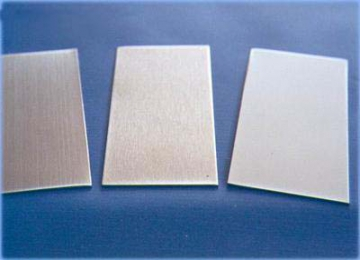
4J29 alloy, also known as Kovar alloy, is an iron-nickel-cobalt alloy with a thermal expansion coefficient similar to that of hard (borosilicate) glass. Matching expansion seals between metal and glass components are required.
The alloy has a linear expansion coefficient similar to that of borosilicate hard glass at 20-450°C, a higher Curie point, and good low-temperature structural stability. The oxide film of the alloy is dense and can be well wetted by glass. And it does not interact with mercury, so it is suitable for use in instruments containing mercury discharge. It is the main sealing structure material of electric vacuum devices.
Microstructure of 4J29 Precision Alloy
After the heat treatment system specified in 1.5, the 4J29 precision alloy should avoid martensitic structure under the condition of freezing at -78.5°C, and the duration should be greater than or equal to 4 hours. However, if the alloy composition is not appropriate, different degrees of austenite to acicular martensite transformation (γ→α) may occur at room temperature or low temperature, and this phase transformation is accompanied by a volume expansion effect. An increase in the coefficient of expansion will lead to increased stress in the alloy and may even cause partial failure of the seal. The chemical composition of the alloy is the main factor affecting the microstructure stability at low temperature. It can be seen in the Fe-Ni-Co ternary phase diagram that nickel is the key element to stabilize the γ phase, and high nickel content is beneficial to stabilize the γ phase. As the total deformation rate of the alloy increases, its structure tends to be stable. The segregation of alloy components may also lead to γ→α transformation in localized regions. In addition, coarse grains will also promote the occurrence of γ→α phase transformation.
Chemical Composition of 4J29 Precision Alloy
material | 4J29 | |||||||||||
chemical composition | C | Mn | Si | P | S | Cu | Cr | Mo | Ni | Co | Fe | |
≦0.03 | ≦0.5 | ≦0.30 | ≦0.02 | ≦0.02 | ≦0.2 | ≦0.2 | ≦0.2 | 28.5-29.5 | 16.8-17.8 | margin | ||
Under the condition that the average linear expansion coefficient reaches the standard, the content of nickel and cobalt is allowed to deviate from the range specified in the table. The content of aluminum, magnesium, zirconium and titanium should not exceed 0.10% each, and the total should not exceed 0.20%.
Mechanical Properties of 4J29 Precision Alloy
material | 4J29 | ||||
mechanical properties | Yield Strength (0.1% Offset)
| Tensile Strength
| Elongation
| ||
psi | MPa | psi |
MPa | (%) | |
49,000 | 340 | 75,000 |
520 |
42 | |
Processing conditions of 4J29 precision alloy
Heat Treatment: Typically, 4J29 alloys require heat treatment to achieve the desired properties. The specific heat treatment parameters will vary according to the specific alloy composition and application requirements. It is recommended to conduct heat treatment according to the technical guidance provided by the alloy supplier.
Machining: 4J29 alloy has high hardness and ductility, and it is necessary to use appropriate tools and cutting fluids during machining to ensure the quality and efficiency of the machined surface.
Application overview of 4J29 alloy
4J29 alloy is widely used, mainly in the field of glass sealing of electric vacuum components. The following is an overview of the application of 4J29 alloy:
Electric vacuum components: 4J29 alloy is often used in the packaging of electric vacuum components, such as launch tubes, oscillation tubes, ignition tubes, magnetrons, etc. It can provide stable sealing performance to ensure the reliability and performance of components.
Relays and integrated circuits: 4J29 alloy is also widely used in the lead-out wires of relays and integrated circuits. Its properties can help achieve high-precision sealing and joining, providing good conductivity and stability.
Chassis and housing: Due to its good thermal expansion matching, 4J29 alloy is often used to manufacture chassis and housings of electronic equipment. It provides stable dimensional properties and maintains structural stability under temperature changes.
Seal Plugs and Brackets: The mechanical properties of Alloy 4J29 make it ideal for use as a seal plug and bracket material. It can provide reliable connection and support functions, and has corrosion resistance and stability.
In general, 4J29 alloy plays an important role in the glass sealing application of electric vacuum components. Its stability, dimensional properties and electrical conductivity make it ideal for critical components in many electronic devices.
What should be paid attention to when using 4J29 precision alloy
When using 4J29 precision alloy, you need to pay attention to the following points:
The expansion coefficient of the glass and the alloy match: In order to ensure the reliability of the adhesive seal, the selected glass should match the linear expansion coefficient of the 4J29 alloy. This reduces thermal stress during temperature changes, preventing seal failure or cracking.
Low-temperature structure stability: According to the service temperature, ensure that the 4J29 alloy has good low-temperature structure stability. This can ensure that the properties and dimensional stability of the alloy are still maintained in a low temperature environment.
Proper Heat Treatment: Proper heat treatment is very important during processing. Heat treatment can improve the deep drawing and drawing performance of 4J29 alloy, make it easier to process and form, and can obtain the required properties.
Air-tightness inspection of forged materials: If forged materials are used, their air-tightness needs to be strictly tested. Ensure that no gas leakage occurs during use to ensure the function and performance of the alloy.
In general, 4J29 precision alloys need to pay attention to matching with glass, low temperature stability, proper heat treatment and airtightness of forged materials during use. These measures can ensure the performance of the alloy and the reliability of the application.

